List of Stratocaster players
This is a list of musicians who have made notable use of the Fender Stratocaster in live performances or studio recordings. The Fender Stratocaster was designed by Leo Fender and Freddie Tavares with involvement from musicians Rex Gallion and Bill Carson in the early 1950s, and since its commercial introduction in 1954 has become widely used among popular artists in rock, blues, and other genres.[1] The Squier Stratocaster is produced by Fender as a more affordable alternative to the Fender-branded version.

Due to the immense popularity of this model, musicians are listed here only if their use of this instrument was especially significant — that is, they are players who:
- have long careers and a history of Stratocaster use,
- have a particular guitar that was unique or of historical importance, and
- have contributed significantly to the popularization of the instrument through their use of it.
A–E
- Billie Joe Armstrong (born 1972), lead singer and guitarist of Green Day, uses a heavily stickered Fernandes Stratocaster copy nicknamed "Blue". Armstrong modified this guitar with a Bill Lawrence humbucking pickup on the bridge position. After sustaining damage from mud during their performance in Woodstock '94, the bridge pickup was replaced with a Seymour Duncan JB.[2] Blue was used on the recording of every Green Day album until Warning, and during live performances of Green Day's early work, such as their songs from Dookie. Armstrong also used a Fender Stratocaster from the Fender Custom Shop while recording Nimrod.
- Randy Bachman (born 1943), a founding member of both The Guess Who and Bachman–Turner Overdrive (BTO) who recently fronted the project "Randy Bachman's Jazz Thing." After a visit to a chiropractor, Bachman was persuaded to switch from a Gibson Les Paul to a lighter Stratocaster. He modified the pickups on his first Strat, putting a Gibson pickup at the neck and a Telecaster pickup at the bridge, while leaving the Stratocaster pickup in the middle.[3] Randy favored Stratocasters and custom Strat-style guitars throughout his years with BTO.[4] Though his bands are mostly known for their simplistic rock-radio anthems, Bachman's soloing often revealed complex melodies and jazz-inflected phrasing. Among his Stratocasters used are a '63 standard and a '71 four-bolt hardtail. He has listed guitar influences as varied as Lenny Breau, Leslie West, Wes Montgomery[5] and Hank Marvin.[6]
- Jeff Beck (born 1944-2023) - a Grammy award-winning rock guitarist, Beck was known for playing for various bands such as the Yardbirds and his own group The Jeff Beck Group. Beck primarily played a Stratocaster and also has a signature Strat.[7] He was noted for his innovative use of the Stratocaster's vibrato system.[8] Up to 1975 Beck had been, primarily, a Les Paul player. In an interview with Jas Obrecht about switching to the Stratocaster, Beck stated, "With a Les Paul you just wind up sounding like someone else. With the Strat I finally sound like me."[9]
- Adrian Belew (born 1949), is an American guitarist, singer, songwriter, multi-instrumentalist and record producer. He is perhaps best known for his work as a member of the progressive rock group King Crimson. He has also worked extensively as a session and touring musician, most famously with Talking Heads, David Bowie, Frank Zappa, and Nine Inch Nails. During much of his career, Belew made extensive use of a weathered-looking Stratocaster, later memorialized in song as "The Battered Strat." This guitar was relic'ed by Seymour Duncan.[10]
- Ritchie Blackmore (born 1945), a founding member of both Deep Purple and Rainbow, and currently a member of the band Blackmore's Night.[11] After starting his career using various Höfner and Gibson guitars, Blackmore switched to a Stratocaster in the late 1960s after seeing Jimi Hendrix perform with one. Blackmore's Stratocasters are modified; the middle pickup is lowered and not used (sometimes disconnected completely) and his Stratocaster fingerboards are all scalloped from the 10th fret up. Through the early/mid 1970s Blackmore was notorious for onstage abuse of his guitars, sometimes destroying them completely. By the late 1970s the guitarist had found a Stratocaster model he was content with and it remained his main stage and studio guitar up until it had to be refretted.
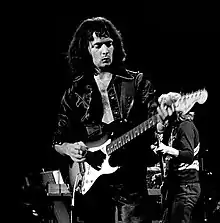 Ritchie Blackmore in 1977.
Ritchie Blackmore in 1977. - Tommy Bolin (1951-1976), a versatile guitarist who is noted for his influence in genres ranging from acoustic blues to hard rock and jazz fusion. He was the lead guitarist for Zephyr, James Gang and Deep Purple. He also had a successful solo career, and collaborated with artists like Billy Cobham, Alphonse Mouzon and The Good Rats. Bolin played by ear and was known for his improvisational skill. His primary guitar was a stock 1963 Stratocaster.[12][13]
 Joe Bonamassa in 2016.
Joe Bonamassa in 2016. - Joe Bonamassa (born 1977), a blues rock guitarist, has used Stratocasters throughout his career. When he was 12 years old, Bonamassa played a crimson 1972 Fender Stratocaster. Bonamassa is known for his extensive collection of vintage amplifiers and guitars.[14] In 2018, Bonamassa has said that he has more than 1000 guitars, a large fraction of which are Fender Stratocasters.[15]
- Bill Carson (1926–2007), a country and western guitarist credited by Fender as "the man for whom the Stratocaster was designed."[16]
- Eric Clapton (born 1945), an English rock guitarist, originally played Gibson guitars early in his career. While he was still a member of Cream, Clapton bought his first Stratocaster, Brownie, in 1969, which was later used on "Layla".[17] Blackie, a composite of three different guitars, went into service in 1970 and was regularly played until its retirement in 1985. It was sold at charity auction for $959,500 in 2004. In 1988, Fender introduced the Eric Clapton Stratocaster, the first model in their Signature series. Clapton has been a long-standing client of the Fender Custom Shop.
- Kurt Cobain (1967–1994), lead singer and guitarist of grunge band Nirvana, used Fender Stratocasters throughout his career, using the guitar in the music video for "Lithium" and in the band's famous performance at the 1992 Reading Festival. Cobain's most well-known Stratocaster has a sticker on the body with the text "VANDALISM: BEAUTIFUL AS A ROCK IN A COP'S FACE."[18]
- Ry Cooder (born 1947), a guitarist, singer and composer who is well known for his interest in American folk music, his collaborations with other notable musicians, and his work on many film soundtracks. Cooder's bottleneck slide guitar playing, heard on such works as the soundtrack to the 1984 film Paris, Texas, influenced other guitarists such as Bonnie Raitt and Chris Rea and contributed to the popularity of the Stratocaster as a slide guitar.[19] He uses a '60s Stratocaster for such playing.[20]
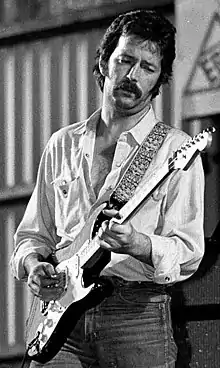 Eric Clapton in a Switzerland concert on June 19, 1977.
Eric Clapton in a Switzerland concert on June 19, 1977. - Robert Cray (born 1953), a long-time blues guitarist and singer, Cray plays a '64 Strat and had his own Signature model made in 1990. The signature model, manufactured by the Fender Custom Shop, combines aspects of Cray's '59 Strat and the '64, omits the standard Stratocaster whammy bar, and includes custom pickups.[21]
- Dick Dale (1937–2019), considered a pioneer of surf rock, was one of the first owners of a Stratocaster; his was given to him personally by Leo Fender in 1955. He has been revolutionary in experimenting with the sound of the guitar by using heavy reverb and a unique fast-picking style as heard on "Misirlou".[22]
F–J
- John Frusciante (born 1970), the current guitarist of Red Hot Chili Peppers, Frusciante used many pre-70s Strats, with the most notable being his worn 1962 Stratocaster. Frusciante used Stratocasters in every Red Hot Chili Peppers album he was involved with, including Mother's Milk,[24] Blood Sugar Sex Magik,[25] and Californication.[26]
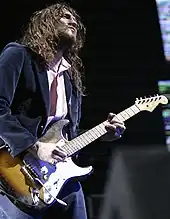 John Frusciante in 2006.
John Frusciante in 2006.

- Rory Gallagher (1948–1995), an Irish blues rock guitarist, often credited as one of the most influential rock and blues guitarists of all time. Gallagher is well known for his worn 1961 sunburst Stratocaster. He described his battered Stratocaster as "a part of my psychic makeup". When asked about its importance, Gallagher said, "B.B. King has owned over 100 Lucilles, but I only own one Strat, and it hasn't got a name."[27] Gallagher's Stratocaster has also been reproduced by the Fender Custom shop, to the exact specs of the original one.[28][29]
- Lowell George (1945–1979), primary guitarist and singer of Little Feat.[30] Lowell was proficient on slide guitar employing his trademark tone which he achieved through use of compression and open tunings helping to define his soulful sound as well as giving him the means to play his extended melodic lines.[31] Additionally, he used to swap the bridge pickups of his Stratocasters for Telecaster bridge pickups.
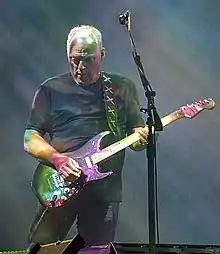 David Gilmour in 2006.
David Gilmour in 2006. - David Gilmour (born 1946), as a solo artist and guitar player for Pink Floyd, Gilmour is credited for his unique, blues-based compositional approach and expressive soloing. Author Tony Bacon stated "his solo on 'Comfortably Numb' remains for many a definitive Strat moment."[32] Gilmour's guitar of choice is a custom modified Fender Stratocaster.[33] He is the owner of Strat #0001, which was manufactured in 1954 but was not the first Stratocaster made since Fender does not use sequential serial numbers.[34][35] Gilmour is considered to be one of the more influential Stratocaster players since the instrument's invention.[36] David's signature black Stratocaster, used frequently in 1970s concerts and on the blockbuster albums The Dark Side of the Moon, Wish You Were Here, Animals and The Wall, is featured in a recent book by his long-time guitar tech Phil Taylor, titled Pink Floyd, The Black Strat—A History of David Gilmour's Black Stratocaster.[37] The "Black Strat" was retired in the 1980s in favour of a Candy Apple Red American Vintage Stratocaster fitted with EMG noiseless single-coil pickups as seen on the Delicate Sound of Thunder and Pulse tours. The Black Strat was briefly used on the documentary Classic Albums: Dark Side of the Moon before being put on display at the Hard Rock Cafe in Miami, Florida. It was finally brought out of retirement by David in 2005 and fitted with a '83 Fender Stratocaster neck for the Pink Floyd reunion at the Live 8 concert. David subsequently used it again for his "On An Island" album and tour in 2006 and when he played "Comfortably Numb" with Roger Waters on his tour of "The Wall" on May 12, 2011, in London and also played most of the leads on the final Pink Floyd album The Endless River and his 2015 solo album Rattle That Lock and its tour.
 Buddy Guy in 1992.
Buddy Guy in 1992. - Buddy Guy (born 1936), an American blues guitarist and singer, Guy is well known for playing the Stratocaster throughout his long career. He is also known for his wild showmanship; Jimi Hendrix and Stevie Ray Vaughan both pointed to Guy as an influence on both their playing and their stage shows. Fender has issued several different variations of a Buddy Guy Signature Stratocaster since the early 1990s; the guitars generally have gold Lace Sensor pickups and modified circuitry.[38]
- Albert Hammond Jr. (born 1980), guitarist for The Strokes, uses a white Fender Stratocaster as his main guitar for recording and live use. Hammond bought the guitar in 1999 for $400,[39] and used it to record albums such as Is This It and Room on Fire. In 2018, Fender released a signature model of Hammond's guitar, featuring a larger headstock and a modified pickup wiring scheme.[40]
- George Harrison (1943–2001), lead guitarist for the Beatles. Harrison and John Lennon obtained matching Sonic Blue Stratocasters in 1965. Unlike Lennon, Harrison employed his Stratocaster more often, using it as his main guitar during the recording sessions for Rubber Soul, Sgt. Pepper's Lonely Hearts Club Band, and the White Album. In 1967, Harrison hand-painted his Stratocaster with a psychedelic paint job, using Day-Glo paint on the body and his wife Pattie Boyd's nail polish on the headstock.[41] The guitar's nickname, "Rocky", is painted on the headstock. Harrison can be seen playing Rocky in the Magical Mystery Tour film as well as The Concert for Bangla Desh.[42][43]
 Jimi Hendrix in 1967.
Jimi Hendrix in 1967. - Jimi Hendrix (1942–1970), known for developing blues in a modern context, Hendrix's main stage guitar through most of his short career was a Fender Stratocaster.[44] Although Hendrix played left-handed, he played a conventional right-handed Stratocaster flipped upside down, because he preferred to have the control knobs in the top position. Hendrix was responsible for a large increase in the Stratocaster's popularity during his career. In reference to his famed on-stage Stratocaster burning on the Monterey Pop Festival, Hendrix is quoted as saying, "The time I burned my guitar it was like a sacrifice. You sacrifice the things you love. I love my guitar."[45] In 1990, the white Stratocaster used by Hendrix at the 1969 Woodstock Festival sold in a Sotheby's auction for $270,000, a record price at the time. In 1997 Fender produced a limited edition Hendrix tribute model Stratocaster.[46]
- Buddy Holly (1936–1959), identified as "the first Strat hero." A statue of Holly in his home town of Lubbock, Texas, portrays him playing his Stratocaster, and the guitar is also engraved on his tombstone.[47] Although the initial release of the Stratocaster came in 1954, the guitar did not begin to achieve popularity until Holly appeared on The Ed Sullivan Show in 1957 playing a maple-neck Strat.[48] Holly was also pictured on the cover of The Crickets' 1957 album The "Chirping" Crickets with a sunburst Stratocaster, inspiring The Shadows' Hank Marvin to adopt the guitar.[36]
- Ernie Isley (born 1952), member of the American musical ensemble The Isley Brothers has developed three custom Zeal Stratocasters from Fender Custom Shop, using his personal design.[49]
- Eric Johnson (born 1954), a Grammy Award-winning guitarist from Austin, Texas, Johnson has played Stratocasters regularly during his career and has played many different types of music. He has participated in developing an Eric Johnson signature Stratocaster model with Fender, which can be bought with both maple and rosewood necks.[50]
K–P
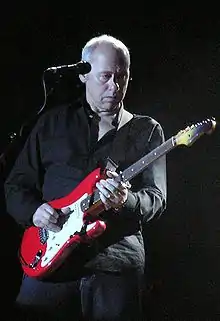
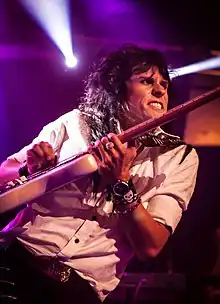
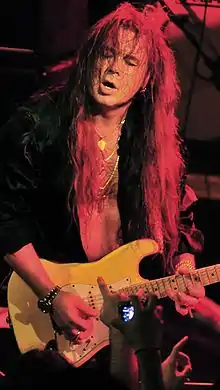
- Ed King (1949–2018) is known for his work with the southern rock band Lynyrd Skynyrd from 1972 to 1975. He used a 1959 model with a black refinish and tortoise pickguard for most recordings and live performances at that time, and also a 1973 model which he used when writing the hit "Sweet Home Alabama".
- Mark Knopfler (born 1949), known for his work with British rock band Dire Straits. Knopfler is known for his very particular and unique fingerstyle playing. The song "Sultans of Swing", from Dire Straits' debut album in 1978, was a huge hit that showed the characteristic tone and technique displayed on Knopfler's red Stratocaster. He used the Fender Stratocaster throughout his entire career, as a member of Dire Straits and his solo career. Fender now produces his Signature Stratocaster.[51]
- Greg Koch (born 1966), known for his incendiary guitar work. Koch was a Fender clinician and ambassador. He played the Stratocaster for many years and even recorded an album called Strat's Got Your Tongue. He is known for his love of Fender guitars.[52]
- Rocky Kramer (born 1990) is known for being a Norwegian "Master Guitarist," now living in the United States. Kramer has been described as a guitar virtuoso "setting fire to the atmosphere with incandescent licks,"[53] as well as "[o]ne of the strongest and most poignant guitarists since Hendrix."[54] Kramer plays and endorses Fender Stratocaster guitars.[55]
- Bruce Kulick (born 1953), long-time member and lead guitarist of Kiss and Grand Funk Railroad. Kulick stated on his personal website that he used a Fender Power Stratocaster, a model with a humbucking pickup in place of the single-coil bridge pickup, to add a harmony solo line to his song, "What Love's All About." Kulick used a 1989 yellow Fender Strat Plus, during the recording of the 1992 Kiss Revenge album, including for the hit single, "God Gave Rock 'n Roll to You II." Revenge reached the Top 20 in several countries.[56][57]
- Michael Landau (born 1958), friend of Steve Lukather and prolific session guitarist of the 1980s, has used many Stratocasters in his career and is working with Fender as of 2016 to create a Michael Landau Signature Stratocaster.[58]
- John Lennon (1940–1980), the Beatles' rhythm guitarist, acquired matching Stratocasters with bandmate George Harrison during the 1965 sessions for Help!. However, Lennon rarely used his Stratocaster, which was notably played on "Nowhere Man" and during the Sgt. Pepper sessions. A different Strat was used on the Imagine album. John Lennon acquired a candy apple red "Strat" with 22 carat gold electroplated brass hardware around 1980. A photo of him playing this guitar in bed one morning in late 1980, shortly before his death, was used an inner sleeve of the album The John Lennon Collection.[59][60][61]
- Alex Lifeson (born 1953), the guitarist for Rush since 1968, first recorded with a black Stratocaster on the Rush 1977 album A Farewell to Kings. In 1979, he modified the '77 Strat with a '57 classic humbucker, a Floyd Rose tremolo unit (first ever made), a Gibson toggle switch on the lower bout, and rewired with master volume/tone. He used that same guitar for the leads and direct recording for 1979's "Permanent Waves." In late 1980, Alex Lifeson acquired two more Strats in red and white, modifying them exactly the same as the former.[62][63]
- Yngwie Malmsteen (born 1963), known for his work in the neo-classical metal genre. Influenced by an array of musicians, Malmsteen is regarded as highly influential for his use of heavy classical-style chord progressions, interesting phrases and arpeggio sweeps. He is known for playing Stratocasters with scalloped fretboards.[64][65]
- Hank Marvin (born 1941), the lead guitarist of The Shadows, Marvin is reputed to be the owner of the first Fender Stratocaster in the UK (given to him by Cliff Richard). The guitar was finished in a shade of Fiesta Red, sometimes referred to as 'Salmon Pink'. This guitar, with its tremolo arm, contributed to the Shadows' distinctive sound.[66] Guitarists such as David Gilmour and Mark Knopfler credit Marvin and The Shadows, who had "the first Strat that came to England", with influencing their own decisions to buy Stratocasters.[36]
- John Mayer (born 1977), a Grammy Award-winning singer/songwriter, has played Stratocasters throughout his career and has had a Fender Artist Series Stratocaster made in both standard and limited edition form.[67][68] Mayer's use of the Stratocaster in a wide range of musical genres is noted as a testament to the guitar's versatility.[19] After tensions with Fender,[69] he partnered with PRS Guitars to develop the PRS Silver Sky, a guitar heavily based on the Fender Stratocaster.[70]
- Mike Oldfield (born 1953), a British guitarist who plays a wide range of guitars and instruments. His "Salmon-pink" strat, bought at the time of his hit Moonlight Shadow, is his favorite guitar.[71]
Q–Z
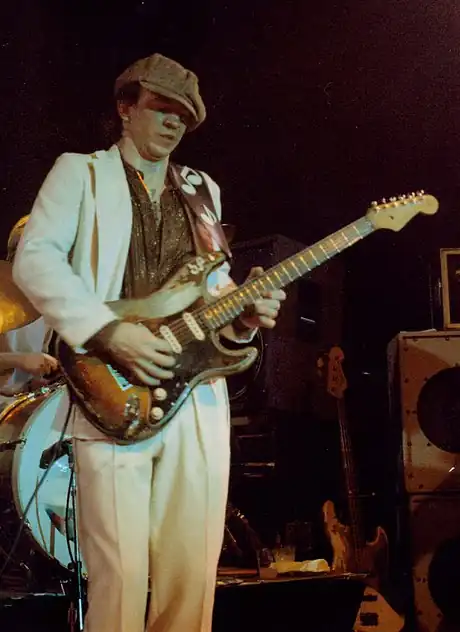
- Trevor Rabin (born 1954), a South African (now has American citizenship) rock guitarist and film score composer. Most well known for his time with Yes (1982-1995; 2015–present), Rabin owns and plays several Stratocasters, and considers it his go-to instrument.
- Bonnie Raitt (born 1949), an American blues/R&B guitarist, singer, and songwriter, plays a 1965 Stratocaster nicknamed brownie, a 1963 sunburst Strat that used to be owned by Robin Trower as well as her signature Strat.[72]
- Robbie Robertson (born 1943), guitarist and principal songwriter for The Band. Robertson's main guitar choice was a Stratocaster, despite using a Telecaster early in his career. For The Last Waltz Robertson had a Stratocaster bronzed especially for his use in the film.[73] More recently Robertson made a very rare live appearance at Eric Clapton's 2007 Crossroads Guitar Festival using a Stratocaster.
- Nile Rodgers (born 1952), an American musician known for his contributions with Chic and unique playing style that makes extensive use of the chop chord, has a 1960 Stratocaster affectionately dubbed as "The Hitmaker" for its presence on many hit singles.[74]
- Kenny Wayne Shepherd (born 1977 Kenneth Wayne Brobst), lead guitarist and lead/backup vocalist for The Kenny Wayne Shepherd Band. Born in Shreveport, Louisiana, Kenny started his playing career at age 16, while attending Caddo Magnet High School, and has performed internationally with many of the great blues legends.[75]
- Richard Thompson (born 1949), an English musician best known for his finger-style guitar playing and songwriting, was a founding member of Fairport Convention before becoming a solo artist. For many years Thompson played a '59 Sunburst Stratocaster, with a maple '55 neck.[76] That guitar is currently unserviceable and Thompson now uses a '64 sunburst Stratocaster with a rosewood fingerboard.[77]
- Pete Townshend (born 1945), the guitarist for The Who, used a Fender Stratocaster during the recording sessions for "I Can See for Miles" and The Who Sell Out.[78] During the Monterey Pop Festival in 1967, Townshend smashed a Stratocaster after the Who's set, which was immediately followed by the Jimi Hendrix Experience's performance where Hendrix also destroys a Stratocaster. Townshend has exclusively used a modified version of the Fender Eric Clapton's Signature Stratocaster since 1989.[79]
- Robin Trower (born 1945), a British rock guitarist known for his work in the band Procol Harum and his successful solo career, has his own Signature Stratocaster made by Fender. "The sight of him onstage with his signature Stratocaster is as characteristic to his fans as his classic songs."[80]
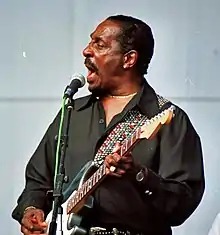
- Ike Turner (1931-2007), an American guitarist, musician, songwriter and record producer known for his work with the Ike & Tina Turner Revue and the Kings of Rhythm. Turner was an early adopter of the Stratocaster, buying one on its release in 1954. Unaware that the guitar's tremolo arm could be used to subtle effect, Turner used it to play screaming, swooping and diving solos. Turner explained his technique by saying: "I thought it was to make the guitar scream—people got so excited when I used that thing." Turner was also known to play Telecasters and Jaguars. In 2004 Fender Custom Shop produced an Ike Turner Signature Stratocaster, limited to 100.[81]
- Ritchie Valens (1941–1959), a pioneer of rock and roll mostly famous for his Latin Rock song "La Bamba", played with a sunburst Strat.[82]
- Eddie Van Halen (1955–2020), guitarist of hard rock band Van Halen, is notable for his "Frankenstrat", a crudely modified Stratocaster copy with the single-coil bridge pickup replaced with a PAF humbucker. This modification made the Frankenstrat one of the earliest Superstrats, which are guitars with a Stratocaster body but different features. A replica of his guitar is located in the National Museum of American History part of the Smithsonian Institution in Washington, D.C.[83]
- Stevie Ray Vaughan (1954–1990), known for his Texas blues style guitar playing, was an American blues guitarist who is considered highly influential for his driving guitar style soaked with rhythmic style playing. Vaughan was noted for playing a Stratocaster equipped with a left-handed vibrato system. He was also known for tuning his guitar down a half-step and using heavy .13 gauge strings.[84][85][86]
- Cory Wong (born 1985/86), rhythm guitarist for Vulfpeck, and known for his clean funk 'lead rhythm' guitar style, used Stratocasters throughout his career. In 2021, Fender released the Cory Wong Signature Stratocaster.[87] A unique feature of this model is the 'fourth position panic button', which uses one of the tone controls to "lock" the guitar in fourth position, and disables the selector switch.
- Ronnie Wood (born 1947), guitarist playing with the Rolling Stones since 1975. Wood's main stage instruments are 1954 and 1955 Sunburst Strats. He also uses a 52 Telecaster.[88]
- James "J.Y." Young (born 1949), guitarist of multi-platinum rock band Styx, has been using a Stratocaster as his principal guitar almost exclusively since 1967.[89]
Tony Joe White (1943 – 2018), nicknamed the Swamp Fox and known for his distinctive Swamp Blues style used a Stratocaster throughout his career.
References
- (Bacon 2000)
- Beckner, Justin. "Story of Cheap Guitar That Launched Green Day Frontman Billie Joe Armstrong's Career". www.ultimate-guitar.com. Retrieved 2022-08-31.
- Goodin, Jesse Kinos. "Randy Bachman: You can never have just one." Article in the Edmonton Journal on September 24, 2012.
- (Prown, Newquist & Eiche 1997, pp. 114–115)
- Bachman, Randy (1998). "Bachman-Turner Overdrive: King Biscuit" (Interview).
- "Randy's Vinyl tap: Past Shows, Cliff Richards & The Shadows". randysvinyltap.com. Archived from the original on 2008-03-21. Retrieved 2008-03-09.
The group's lead guitar player, Hank Marvin, has been a huge influence on many over the years including Frank Zappa, Neil Young, Carlos Santana and of course Randy Bachman.
- (Chapman 2003, pp. 25–17)
- (Marten 2007, pp. 48)
- Ferguson, Jim (editor): The Guitar Player Book - Revised Third Edition, 1983. GPI Publications. ISBN 0-394-62490-4.
- "elephant blog: Antarctica volume 2 number 11". 2007-08-20. Retrieved 2011-04-13.
- (Kitts & Tolinski 2002, p. 42)
- Jisi, Chris; Bosch, Mark (November 1988). "Shooting Star". Guitar World.
- Cauffiel, Lowell (March 1977). "Tommy Bolin interview". Guitar Player. Retrieved 2007-01-11.
- Perlmutter, Adam (20 June 2016). "Joe Bonamassa Shares His Rare Les Pauls and Other Guitars". guitarplayer. Future Publishing Limited Quay House. Retrieved 29 January 2019.
- Bienstock, Richard. "The Nerdville Redemption: Tone Can Set You Free". Guitar Player. Future Publishing Limited Quay House. Retrieved 29 January 2019.
- (Duchossoir 1994, p. 6)
- (Chapman 2003, p. 153)
- Kurtsguitarsnow (2009-05-13). "Kurt Cobain's Guitars Now: Vandalism Stratocaster". Kurt Cobain's Guitars Now. Retrieved 2022-08-31.
- (Marten 2007, pp. 49)
- "Ry's Hardware". RyCooder.nl. Retrieved 2008-01-08.
- "Robert Cray Interview". Modern Guitars Magazine. 2005-06-29. Archived from the original on 2006-12-09.
- (Kitts & Tolinski 2002, p. 56)
- (Kitts & Tolinski 2002, p. 94)
- johnfrusciante.com "A Fender Strat (year & Model type unknown)"
- johnfrusciante.com "known to have been used: Various Fender Stratocasters"
- johnfrusciante.com "Guitars: [...] '55 Fender Strat, '62 Fender Strat,
- Minhinnett, Dave (1994). "Rory Gallagher Interview". Modern Guitars. Archived from the original on 2014-02-21.
{{cite web}}: CS1 maint: bot: original URL status unknown (link) - Instruments, Fender® Musical. "Rory Gallagher Signature Stratocaster® | Artist Series | Fender® Custom Shop". www.fendercustomshop.com. Retrieved 2020-04-17.
- Gallagher, Dónal (2004-05-11). "Rory's Fender Strat". Strat Collector. Archived from the original on 2012-03-03.
{{cite web}}: CS1 maint: bot: original URL status unknown (link) - Tobler, John (1992). NME Rock 'N' Roll Years (1st ed.). Reed International Books. p. 283. ISBN 0600576027.
- Brend, Mark (2002). Rock and Roll Doctor: Lowell George: Guitarist, Songwriter, and Founder of Little Feat. Backbeat Books. pp. 75. ISBN 0879307269.
- (Bacon 2006, pp. 108)
- (Chapman 2003, p. 161)
- Mahon, Richard. "#0001 of a Kind". Spare Bricks. Archived from the original on 2007-12-01.
- Sinclair, David (May 1983). "Interview with David Gilmour". Guitar Heroes Magazine (9).
- (Marten 2007, pp. 44)
- Guitar World, Vol. 29, No. 7 (July, 2008), p. 46.
- (Kitts & Tolinski 2002, p. 30)
- "Guitars: Albert Hammond Jr, Hammarsing Kharmhar". www.thecurrent.org. Retrieved 2022-11-08.
- "Fender Releases Albert Hammond Jr. Stratocaster". Premier Guitar. 2018-11-20. Retrieved 2022-11-08.
- Scapelliti, Christopher (2017-04-12). "George Harrison Talks About His "Rocky" Fender Stratocaster". guitarworld. Retrieved 2022-11-08.
- (Bacon 2000, pp. 76–77)
- (Bacon 2006, pp. 76)
- (Chapman 2003, pp. 190, 192)
- (Marten 2007, pp. 44, 46)
- Seven Fender Stratocaster Models That Pay Tribute to Jimi Hendrix November 13, 2004 - Modern Guitar Magazine
- (Duchossoir 1994, p. 16)
- Sheedy, Chris (2007-11-11). "Icons in the Beginning". The Sun-Herald.
- Paule, Marty (2014-03-19). "A Conversation with Ernie Isley of The Isley Brothers | The HUB". The HUB from Musician's Friend. Retrieved 2018-04-23.
- (Kitts & Tolinski 2002, pp. 44–45)
- "Mark Knopfler Stratocaster". Fender Products. Archived from the original on 2005-04-06. Retrieved 2007-01-13.
- "Greg koch - Strat's Got Your Tongue". Grooveyard Records. Grooveyard Records Inc. Retrieved 2 January 2018.
- Randy Radic (14 July 2020). "Rocky Kramer Struts His Talent on 'Firestorm'". Hollywood Digest Magazine. Retrieved 2020-11-21.
- Shapiro, Eileen. "Rocky Kramer – A Musical Virtuoso". Official Fame Magazine. Retrieved 2020-12-15.
- "Rocky Kramer "Rock Star In The Truest Form"". The Hype Magazine. Retrieved 2020-10-19.
- "Bruce's Studio Blog". Kulick.net - The Official Bruce Kulick Website. Bruce Kulick. Archived from the original on 2007-10-17. Retrieved 17 October 2007.
- "Kiss Guitar of the Month - February 2020". YouTube.com. Bruce Kulick. Archived from the original on 2021-12-19. Retrieved 31 January 2020.
- "Fender Custom Shop Announces Michael Landau Signature". www.iguitarmag.com. Retrieved 2016-04-27
- "The 1980-1983 Fender "STRAT"". 2018-06-20.
- "The John Lennon Collection".
- lennon7
- "Alex Lifeson". MusicToyz. Archived from the original on 2006-12-17. Retrieved 2007-01-11.
- Geiger, Jim. "Rush Gear & Gizmos: Alex Lifeson". Rush Archives. Retrieved 2007-01-11.
- (Kitts & Tolinski 2002, p. 45)
- (Bennett 2002, p. 93)
- (Bacon 2006, pp. 70)
- "John Mayer Stratocaster". Fender.com. Archived from the original on 2007-07-14. Retrieved 2007-07-30.
- "Limited Edition John Mayer Stratocaster". Fender.com. Archived from the original on 2007-09-29. Retrieved 2007-07-30.
- Orkin (2014-10-17). "John Mayer Announces Split with Fender". reverb.com. Retrieved 2022-08-27.
- "PRS Guitars Announces the John Mayer Silver Sky". Premier Guitar. 2018-03-05. Retrieved 2022-08-27.
- Maconie, Stuart (2001-04-26). "Tubular Net". Seven More Days That Rocked The World. Retrieved 2007-01-12.
My favourite one is a salmon-pink Stratocaster, it's the same sort used by Hank Marvin in the Shadows
- "Information on Bonnie's Strat". Guitar player, Bonnie Riatt Stratocaster. Archived from the original on 2006-10-30. Retrieved 2007-01-13.
- Robbie Robertson (2002). The Last Waltz (DVD commentary track). MGM/United Artists.
- Farrell, Jason (23 Jan 2014). "Fender Custom Shop introduces Nile Rodgers Hitmaker Stratocaster". Fender.
- "Kenny Wayne Shepherd".
- "Gear & tunings". Richard Thompson official website. 2006-12-20. Archived from the original on 2007-01-12. Retrieved 2007-01-14.
- "MORE Questions and Answers". Richard Thompson official website. 2006-10-13. Archived from the original on 2007-04-29. Retrieved 2007-04-21.
- Whotabs. "Pete's Gear: Pete Townshend Guitar Equipment History | Pete Townshend's Guitar Gear | Whotabs". www.thewho.net. Retrieved 2022-08-27.
- "Pete's equipment". Who Tabs. 2004-03-01. Retrieved 2007-01-11.
- Holland, Brian D. (2006-02-23). "Robin Trower Interview". Modern Guitars. Archived from the original on 2006-12-05. Retrieved 2007-01-11.
- "Ike Turner 1931-2007". Fender News. Fender Inc. Archived from the original on 16 January 2017. Retrieved 5 October 2011.
- "Musicians who played a Stratocaster". 2006-03-16. Retrieved 2007-03-16.
- "National Museum of American History Receives Eddie Van Halen's "Frankenstein Replica" Guitar" (Press release). Washington DC: Smithsonian Institution Newsdesk. 2011-09-07. Retrieved 2014-07-12.
- (Kitts & Tolinski 2002, p. 27)
- (Bennett 2002, p. 188)
- (Chapman 2003, p. 61)
- "Cory Wong Stratocaster". www.fender.com. Retrieved 2021-07-29.
- New Page 1 Archived 2012-09-18 at archive.today
- "James Young- The Guitar Player Interview". Guitar Player. 1981-07-01. Retrieved 2007-02-21.
Sources
- Chapman, Richard (2003). Guitar: Music, History, Players. DK publishing. ISBN 0-7894-9700-X.
- Bacon, Tony (2000). 50 Years of Fender: Half a Century of the Greatest Electric Guitars. Balafon. ISBN 0-87930-621-1.
- Bacon, Tony (2006). Electric Guitars:The Illustrated Encyclopedia. Thunder Bay Press. ISBN 1-59223-053-9.
- Bennett, Joe (2002). Guitar Facts. Hal Leonard Corporation. ISBN 0-634-05192-X.
- Duchossoir, A.R. (1994). The Fender Stratocaster: A complete guide to the history and evolution of the world's most famous guitar. Hal Leonard Corporation. ISBN 0-7935-4735-0.
- Kitts, Jeff; Tolinski, Brad (2002). The 100 Greatest Guitarists of All Time!. Hal Leonard Corporation. ISBN 0-634-04619-5.
- Marten, Neville (2007). Guitar Heaven. HarperCollins. ISBN 978-0-06-135944-6.
- Prown, Pete; Newquist, H.P.; Eiche, Jon F. (1997). Legends of Rock Guitar: The Essential Reference of Rock's Greatest Guitarists. Hal Leonard Corporation. ISBN 0-7935-4042-9.
- Ferguson, Jim (1983). The Guitar Player Book-Revised Third Edition. GPI Publications. ISBN 0-394-62490-4.
